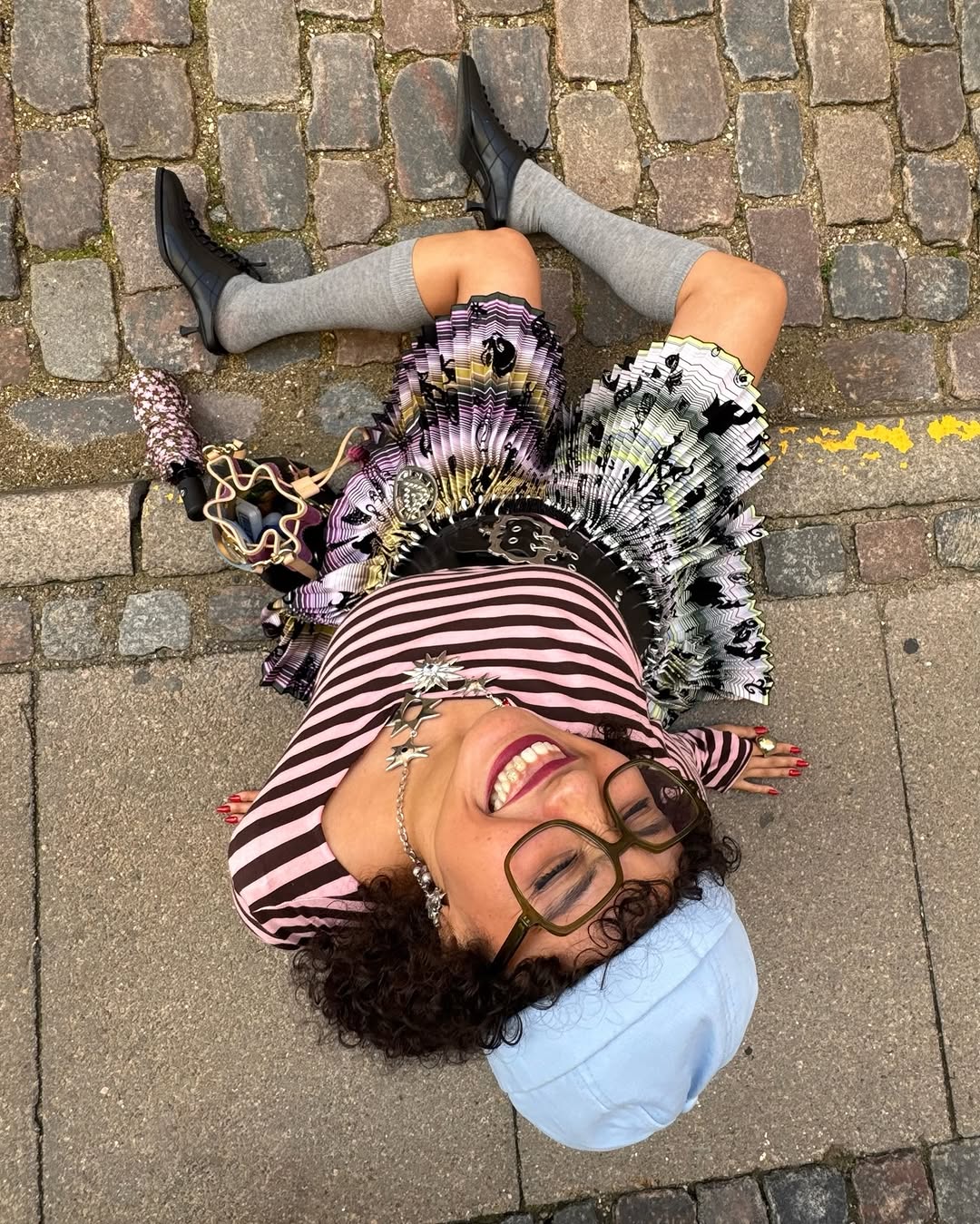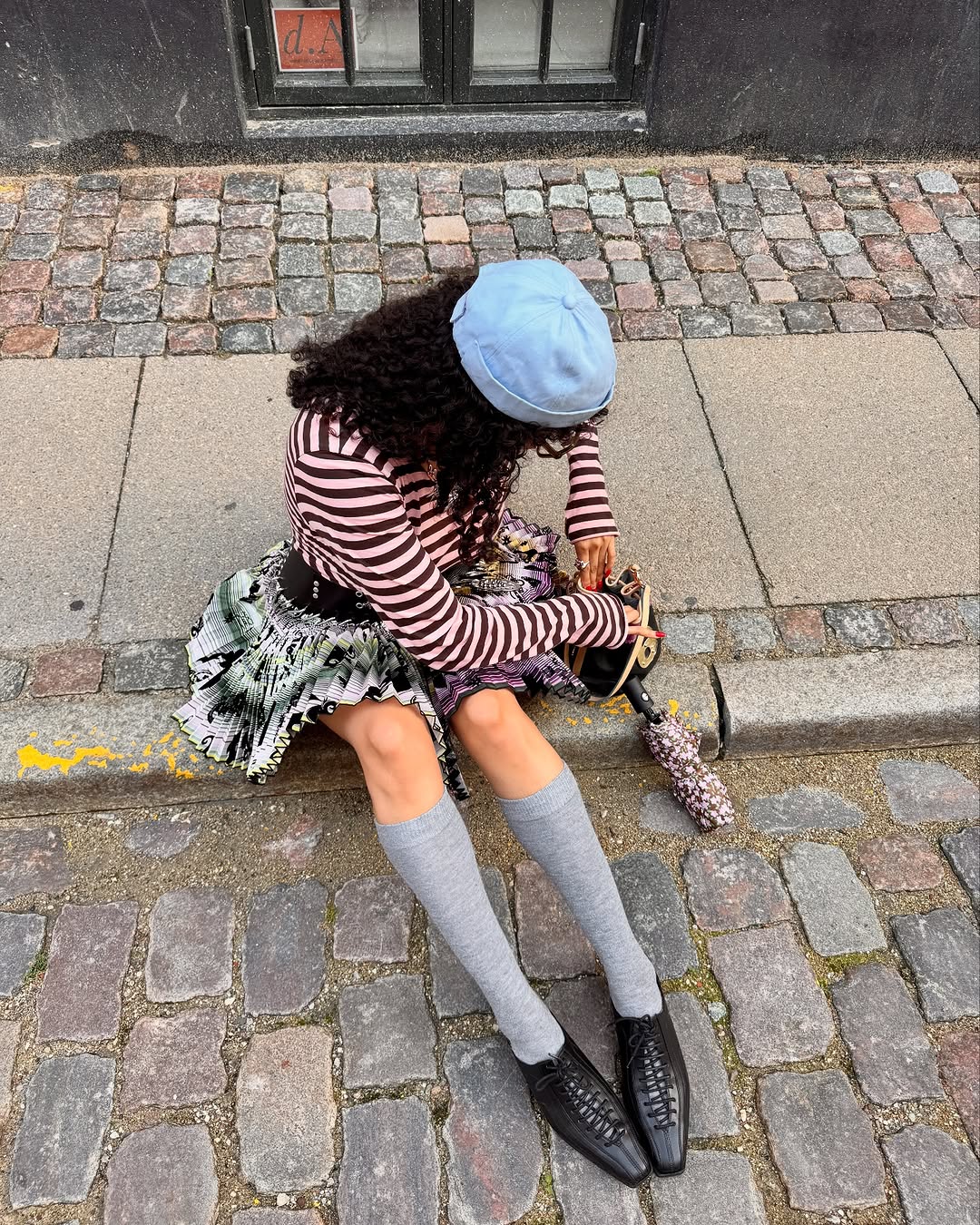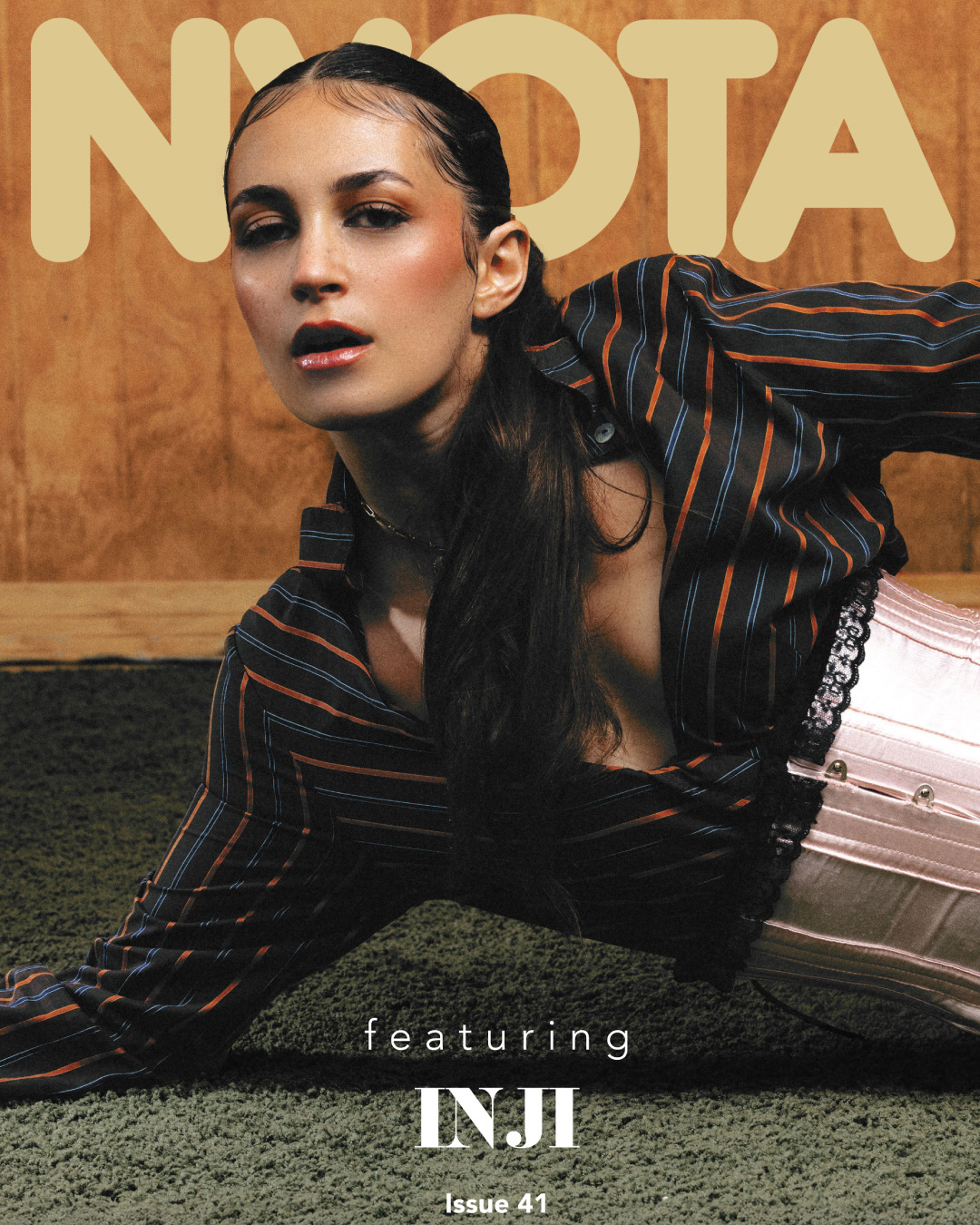Jazmine Brown, better known as That Curly Top across social media, has been brightening people’s feeds with her colorful and eclectic looks for the past few years. Brown hopped on the phone to speak to NYOTA about her style journey, brands that are genuinely committed to sustainability, and pressing pause on her platform, Sustainable Baddie.

Were you the kind of kid who insisted on picking out your own outfits? If not, when do you think you started developing your own sense of style?
I was always a bit of a quirky, weird kid. That’s just a part of my lore. My mom used to dress me up, and that set me up to dress a little bit more flamboyantly. I was the firstborn, so she treated me like a doll, and then I took it upon myself to dress the way I wanted to. I remember one time when I was watching Christina Aguilera in a concert on TV, and I ended up cutting up one of my shirts. My mom got mad at me, but that’s just how I was as a kid. Because I was weird, I started getting bullied at school, and it took a lot of my confidence away, and I enclosed myself in a bubble where I ended up wearing the same thing every day, and it was a really bad outfit. It was just a little gray hoodie and some jeans that didn’t fit me properly, and the same shoes, and that was throughout seventh grade, which was one of the worst times of my life. Then I felt like I was doing this to myself by leaning into this; I felt like I could try to change my persona so I fit in better. So I tried dressing in what was more trendy at the time, and I did that, but nothing really changed, and I wasn’t happy with myself.
Throughout high school, I began experimenting with my style more and noticed the impact of how my clothing choices made me feel. By the time I arrived at college, I wanted to study fashion and was in a very new space. It was the first time I attended a predominantly white institution, and I wanted to reinvent myself, so I fell back into the same thing I did in eighth grade, where I tried fitting in, and I was shopping on my own for the first time and bought all these trendy clothes. Since I didn’t grow up with a lot of money, I did a lot of DIY and thrifting when I was younger, and when I got my first paychecks, I was shopping at fast fashion stores at the mall every other week. That didn’t make me happy. I was losing a lot of money, and it was like I lost all my confidence again. Along the way, I learned about sustainability and started implementing those values into my life. It ended up being a parallel journey where I rediscovered my personal style, which led me to be more playful and become the person I am today. Leaning into sustainability really helped me slow down and figure out what I actually wanted to wear and who I was. It’s been a journey of rediscovering my voice and self-confidence.
You play a lot with color, patterns and layers when putting together your outfits which is rare to see online nowadays as so many people subscribe to a more neutral color palette. How has living in NYC influenced your creativity in putting together outfits and playing with different palettes?
It’s interesting because I was at my most maximalist when I lived in San Diego, which is where I was living before New York. I was reflecting on this with one of my friends, and in San Diego, I felt more maximalist because it was the only way I could have my inner voice shine through. Externally, I wasn’t in an environment where I could feel my full, authentic self. Since being out here [in New York], I’ve developed less of a maximalist style, but I feel more comfortable in an eclectic style because eclecticism is truly at the core of what I really like. It’s a thing where, whether I was a maximalist or eclectic, New York has been a great place for me to explore my personal style and what feels true to me because no one really cares if I’m a maximalist or not. You can dress as loud as you want, and there’s no shame around it, versus in San Diego, it was almost expected that people would look down on me. I am heavily inspired by all the other creatives out here as well, because they’re on similar journeys of trying to figure out how to creatively express themselves.

Due to younger consumers’ growing interest in thrifting and shopping more sustainably in recent years, it seems that the fashion industry is adapting its practices to attract these consumers. Are there any larger fashion brands that you believe are genuinely committed to sustainability, rather than simply jumping on a bandwagon?
One of the brands that comes to mind that genuinely is trying to change is Coach and its subsection Coachtopia. They got called out a few years ago, and most brands that get called out try to bury the lede with a temporary initiative, but since then, Coach has actually invested in trying to be better on multiple different levels. I haven’t really seen that from other brands; some of them might do a one-time thing or have a second-hand section, and that’s as far as their initiatives go. Coach has really been better about their materials, and they’ve gotten better with the garment workers. That gives me hope that other brands do have the possibility of doing so; it’s going to take the consumers to be able to push them and twist their arm for this. At the same time, I was telling someone that I find it encouraging when bigger brands actually start implementing more sustainable initiatives. Not putting them on a pedestal, but it’s a reflection of culture and what we want as consumers, and because we want these things, brands are forcing themselves to take initiative. Even though it could be considered greenwashing, they’re still doing it, and that gives me hope as well. It doesn’t matter to me sometimes where the intention is coming from; it’s the impact, and if they’re forcing themselves to impact the world in a different way in order for them to make more money, at least they’re doing something differently. But we can’t stop there with brands; we have to keep demanding more.
As the Sustainable Baddie website states, sustainability can be intimidating, and that rings true because when people hear the words dress sustainably, they often assume that drastic life changes are required for this to happen. In what ways do you think your content can encourage people to make the little changes that count?
It all stemmed from my own journey, as I began learning more about the harmful effects of the fashion industry and how interconnected everything is. It was so insanely depressing and made me feel small. I ended up ignoring all those facts for a year, because if it’s as bad as it is, surely someone would have already stopped this by now, which was naive to think. It got to a point for me where I couldn’t consciously move forward in the fashion industry unless I was part of changing it. I realized what was holding me back, and what I wanted to see was people who looked like me – people who loved fashion and had fun with it, because style and caring don’t have to be separated. I only discovered a few people who were like that because the people already doing it weren’t being talked about or easily seen. So, I started creating because all of it seemed so doom and gloom when you first looked at it. However, there are actually many solutions out there and people doing amazing things. I wanted to be a role model and showcase what others were doing. I hit a point where I realized I was one person with one perspective, and there were so many people out there doing incredible work whose stories weren’t being told, who were contributing so much to the world. That’s why I ended up creating Sustainable Baddie, because there are so many sustainable baddies out there who are killing it, and I wanted to create a hub to give people hope. It’s so easy to feel isolated, and when you find yourself feeling isolated, it’s easy not to want to do anything, but when you see other people who can give you hope, you realize you’re not alone.

Nowadays, when content creators want to discuss topics that are considered “controversial” on their social media, they’re often advised against doing so due to potential backlash. I love that on your page, you discuss political happenings alongside the fashion-centered content, because it proves that you can cover these topics while maintaining your audience. Given the current political climate, are you hoping others will start to feel emboldened to use their voice?
Absolutely. It feels weird that this is a thing for people because it’s what I’ve been doing since day one. I was fortunate enough to build my platform while always being somewhat political and being able to have a stance, while also doing the things I love. It’s probably inherent to me and my audience, for me, I ask the question, do you even want to associate or work with people who don’t want you to speak up in that way? I don’t know if it has stifled my growth or if I would be bigger if I didn’t speak up on political things, but I’m still able to make a living off this and get work, and if that comes at the cost of not being able to be as huge or make as much money, that’s such a privilege in itself. Influencers make stupid money, and it’s worth it to be able to use that platform and privilege to speak about those things, because there are so many people who have jobs where they can’t speak up or else they’d get fired. We have such a privilege to control what we’re putting out into the world, and I hope people can see that it does more good than harm to be able to step out and do something.
You decided to hit pause on Sustainable Baddie for the time being, which couldn’t have been an easy choice. What did creating the platform teach you, and what do you hope readers/the broader Sustainable Baddie community take away from the platform?
I don’t know how long it’ll be the way it is, but say hypothetically, people come across it five years from now, and it’s still dormant. I hope people see it and know people have been doing this for a long time, and the people who have been doing this work are cool and unique. I hope people can get inspired by that and want to become a sustainable baddie themselves. I want Sustainable Baddie to be a touch point for people to launch themselves into whatever they feel inspired to do. I’ve heard stories of that while we were operating, and I could imagine it continuing to do so. I still have ideas for it, but it’s been on pause due to current political events. I was climbing so many hills trying to build a media, fashion, and sustainability company, while also trying to do it all ethically and inclusively. The current administration’s lack of funding for inclusivity and climate has made it even more difficult, and there is uncertainty surrounding media entities and AI. I want the essence of Sustainable Baddie to keep living on, and I want to adapt it into other things that can still be impactful.

You started a Substack back in January. Do you think this platform can be a new space for the Sustainable Baddie mission to continue?
I do want it to be an extension of that eventually. It’s funny because I started writing, and then one of my articles did really well. I told myself at the beginning of the year that I wanted to create more than I consume and explore different avenues of creativity for myself. Writing has been one of those things that I’ve always admired and wanted to do, which is why I started Sustainable Baddie, but I hired writers to talk about topics they wanted and ideas I gave them. With Substack, I was like, I should probably just write about the things I want to write about, but because I got so many eyes on one of the articles I did. I became insecure because it’s not necessarily my forte, and I don’t consider myself a writer, but I’ve been battling with that again and thinking about how nothing requires perfectionism; it just requires us trying, and if I have a voice and want to share, even if it’s imperfect, I should go ahead and share it anyway. I’m picking back up the confidence to write again, and I do feel that writing in itself is becoming a lost art form with people’s attention spans, media literacy, and the works. So it would be nice to get back into it again.
What advice do you have for aspiring content creators?
It sounds generic, but truly talk about whatever it is you’re passionate about. People grab onto what people are passionate about. I’m really passionate about sustainable fashion and things like that. When these kinds of conversations happen, people can gravitate towards them because they can see how genuine I am around them. It’s not necessarily having to find your niche; it’s finding what it is that you’re passionate about that you want to talk about, because nobody wants to hear you yap on about something that you don’t care about. You don’t have to put yourself into a box to be seen or noticed.
This story first ran in NYOTA’s Empowerment Issue. Read more from the Issue here and purchase a print copy here.




